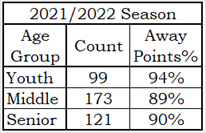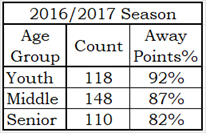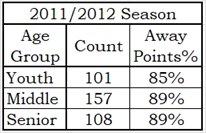Dave Smart was an incredibly successful coach with the Carleton Ravens basketball team (Canadian University). Over a period of 14 seasons, his team’s average record was 21-1. What has that got to do with hockey? He is presently a consultant to the coaches of the Ottawa Senators, and he has a regular interview with TSN 1200 where the central topic is hockey.
On a recent show (October 12th if memory serves) he noted that young players play worse on the road than they do at home, while veterans play better on the road than at home.
Why Would Young Players Play Worse on the Road?
Young players may well be visiting big cities for the first time and could be easily distracted by all the activities available to them. At home they will quickly get used to whatever activities are available in their city and they will have a daily routine focused on hockey.
Older players have families, which means they have children, so they have constant duties and distractions at home. On the road, they have the tranquility of their hotel room to enjoy, they have no duties, and they can have a daily routine focused on hockey.
While his reasoning was logical, I decided to see if the data agreed with him.
How Can Home/Road Player Data be Quantified?
An obvious statistic to use to determine how well a player plays on the road is points. We have to be careful, as home teams win more often than visiting teams, which means they score more goals than visiting teams, which means home players will have more points than visiting players. Even when it is the same player.
A randomly selected player from 2021/2022 is Charlie McAvoy. McAvoy scored 29 points in home games, 27 in road games. He scored 93% as much in road games as home games; this is what we would expect based on the home team advantage.
But one player does not a study make. Let’s add a few more players: 392 more, to be precise.
I’m going use players who were rated as PR-Regular or better in 2021/2022 (see Introduction to Productivity Rating for more information on PR). At the team level, PR-Regular or better represents forwards who play on the top three lines and the top four defensemen.
In 2021 there were 393 players who were PR-Regular or better. They had 9,035 points at home, 8,198 points on the road. Their road scoring was 91% as much as their home scoring. That’s the big-picture context for the 2021 season: players, as a group, score 91% as much on the road as at home.
We’re ready to look at the data by age groups, as Coach Smart compared young players to old players in his assertion.
Home and Road Points by Age Groups
I identified three age groups for this analysis. Young players were younger than 25 years old, a middle-aged group was 25 to 29 years old (inclusive), and old players were more than 29 years old.
If Coach Smart’s reasoning is accurate, the young players will be below 91%, the old players will be above 91%, and the middle group would be close to 91%.

The data indicate that Mr. Smart’s reasoning was inaccurate.
The youths were above 91% while the middle and senior groups were slightly below 91%. This is close to the exact opposite of what we would expect based on Coach Smart’s declaration.
2021 could have been a one season stroke of good luck for the youngsters. Let’s go back five seasons to 2016. Going back five seasons will put every player in this table in a different age group. This will indicate whether the data is affected by the players or by their ages.

The average player in 2016 scored 87% as much on the road as at home. A look at the table shows that things have gotten worse for Coach Smart’s contention: this is exactly the opposite of what would be expected.
If there is a drawback to using points, it is that forwards score more than defensemen. I checked to see if the results were overly influenced by forwards. In 2021, defenseman away scoring was 92% as much as home defenseman scoring, while forwards were at 91%. In 2016, it was 86% for the defense and 88% for the forwards. Forwards and defensemen were equally as effective in both seasons.
I stepped back one more five-year span to the 2011 season.

We are looking at data from ten years ago, when Erik Karlsson and Jason Spezza were the best players on Ottawa, and the 26th-place Toronto Maple Leafs were led by Dion Phaneuf and Phil Kessel. The average road player was 88% of the scorer he was at home. This season’s numbers are in the Dave-Smart-assertion pattern, with young players not doing as well on the road compared to the older players.
The effort to do one season is just enough that I’d need a compelling reason to do them all, and the results are not compelling enough. The numbers will probably bounce around a bit from season to season, but in general the numbers will rarely support the assertion.
Is There Another Way Than Points to Measure Player Productivity?
Productivity Rating (PR) is another way. It uses fourteen statistics to assign a player a Productivity Score (PR-Score) which is then converted to a Productivity Category (PR). Charlie McAvoy, the previously cited example, was a PR-Star in 2021.
I came up with a process that assigns a share of PR-Score to players in their home and away games. It is a little technical to go into, but I’m satisfied as to its accuracy. The result of the calculation is called PR-Share. Each player has a home and road PR-Share value.
PR-Share tells a similar story as does points, in a slightly more muted manner.
There are two final notes.
First, I should make it clear that some players get better results on the road than at home in some seasons. Over the three seasons that were investigated, about 20% of the players had more points on the road than at home.
Second, there were 64 players who were part of all three seasons investigated. Alphabetically they ranged from Adam Henrique to Zdeno Chara. Their numbers from season to season could vary greatly, indicating that the Gods of hockey do not consistently grant their blessings. Brad Marchand’s road PR-Share percentage over the three seasons were 84%, 121% and 80%, while Ryan McDonagh went 114%-91%-113%.
Myth: Busted
Putting the results of three seasons together, from youngest group to oldest group, the away points percentages are 90%, 89% and 87%. While 90% isn’t really all that different from 87%, the 90%-89%-87% pattern is the opposite of what Dave Smart’s claim would produce.
The concept that young players play worse on the road than at home can be put into the same trash-bin that holds adages like “a two-goal lead is the worse lead in hockey” and “Punxsutawney Phil can predict weather.” While there are occasions when Phil gets it right, and there are occasions when a team blows a two-goal lead, they are exceptions rather than the rule. The rules are: Punxsutawney Phil’s long-term weather forecast is even more inaccurate than those that come from professional weather forecasters; a two-goal lead is way better than the worst lead in hockey (a one-goal lead), and; young players do not play worse on the road than do older players.
